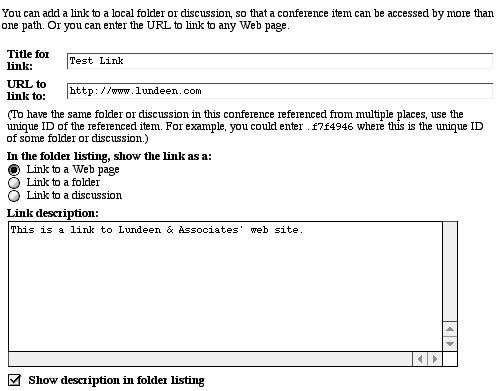| Creating
and Using Links
Creating
and Using Links
Linking
to Macros and HTML Files
Troubleshooting
Resources
Creating
and Using Links
A Web
Crossing "link" created from the Add Link button
is really an alias, or shortcut, to another Web Crossing object
or an outside HTML document. Links make it possible for a given
folder or discussion to "live" in more than one place
in your Web Crossing site.
This
is to be distinguished from an HTML link, which you can make with
regular HTML in any text area within Web Crossing.
Sysop
and hosts can always add links. You can give Registered Users
(or Guest Users) the ability to create links in the Control
Panel > User Management > Registered Users and Control
Panel > User Management > Guest Users. Once you've
done this, you can configure an individual folder so that users
can't add links if you wish. Use the Edit Folder button
to find the area to do this.
The
Title for Link will be what's displayed in the containing
folder's contents list. The URL To Link To field indicates
where the link will go. If you're linking to another Web Crossing
page, you must use that folder or discussion's unique
seven-digit hex number with the leading period. (Full
paths won't work.) If you're linking to an external HTML document,
type or paste in the URL (including the http:// part, or it won't
work).
You
have the option to show the link as a web page (giving it a lightning
bolt icon  ),
a folder (giving it a folder icon ),
a folder (giving it a folder icon  )
or a discussion (giving it a discussion icon )
or a discussion (giving it a discussion icon  ). ).
If you
want to describe the link, type into the larger Description
text box and be sure the show description in folder listing
checkbox is enabled before you click OK.
Links
can be edited by hosts and sysop after they've been posted, by
using of the Edit button which appears next to the link.
To delete a link, click on Edit and then find Delete
at the bottom of the page.
Figure
1 - Creating a Link

Figure 2 - The Link's Appearance (with the optional description)
in the Containing Folder (only sysop and hosts see Edit button)

| Note:
One little oddity about links and access
lists: The only way to set an access list for a link is
to create the link, then click on it and follow the link.
At the location, click on Access List and create the
access list. This access list will then be for both the link
and the original object. Normally when someone has "no
access" for a folder, discussion, etc. they don't even
see the item listed in the contents of the containing folder.
But with an access list on a link, they will see the link,
but are told they don't have access when they attempt to enter. |
Linking
to Macros and HTML Files
You
can create a Web Crossing link to a macro you've written.
In the
form where it asks for the URL, put:
macro=myMacroName
When
the user clicks on this link in the folder listing, they'll see
a "normal" Web Crossing URL with a unique ID number:
http://yoursite.com/webx?14@251.oqPTaj9a6fi^0@.ee6b9d8
not
a usual macro link:
http://yoursite.com/webx?myMacroName@251.oqPTaj9a6fi^0@
If you
create this link in a folder with an access list on it, you can
protect access to your macro. You should be aware, though, that
if anyone happens to know the name of your macro, they will be
able to construct a URL to get access to it anyway. But since
your macro name isn't visible in the URL, it will be much more
difficult for anyone to guess the name of it. If you plan to use
this technique, it's obviously best to choose unusual macro names
that someone isn't likely to stumble on by guessing.
You
can also link to static, WebX-served files.
You can
link to static files in the webx/html directory or in the webx/htmlLinks
directory. If your files are within the htmlLinks directory, however,
any access controls on the link (i.e. on the folder the link is
in) will be applied to the file being linked to, and you can create
private static files in this way. See Access
Lists for Macros and HTML Files and the
webx/htmlLinks directory.
If your
files are in the webx/html directory, you can still link to them,
but it's not possible to control access.
To
link to an individual file:
file=test/abc.html
This
will serve the file named "abc.html" that lives within
the /test directory within the htmlLinks directory.
Troubleshooting
My link
doesn't work.
- Check
to see that your unique ID number is correct and that you've
included the leading period.
- Check
to see that you've included the http:// part for an external
link and that you haven't made a typo.
I typed
in a description but it's not showing on the page.
- Did
you check show description below the link description
box?
Resources
Sysop
Documentation
|

